7 Creative PLG Email Campaigns You Can Power with Amplitude Data
Learn how to leverage Amplitude data to run personalized email marketing campaigns that help drive product-led growth.
The product is the primary channel for growth in PLG. In fact, that’s the very definition of the concept. But other channels also help accelerate growth. And email marketing is one of the best for product-led businesses because it:
- Has a high return on investment (ROI) ($36 for every $1 spent)
- Reaches the executive sponsor who doesn’t spend a lot of time using the product
- Is effective in bringing back disengaged, distracted, and churned users
- Enables the communication at scale required for top-of-funnel PLG tactics
- Delivers personalization at scale
Email complements your PLG strategy at every stage of your customer journey.
Get ready to be inspired by these seven product-led email campaigns you can run using Amplitude data, in combination with an email provider that ingests CDP events like Inflection.io.
1. Onboarding emails
The top factor that distinguishes a great onboarding email from others is and always has been personalization. Loom is a great case study on how to use personalized onboarding emails to drive PLG.
Loom personalizes the first email users receive with options to join an existing workspace, create a new workspace, or use the product for a personal project. (The personal project users do not receive the first email shown here.)
The next onboarding emails share tips on how users can record their first video, celebrate that milestone, and share it with the world, with insights about the views in the next email. Users’ product activity triggers the relevant emails.
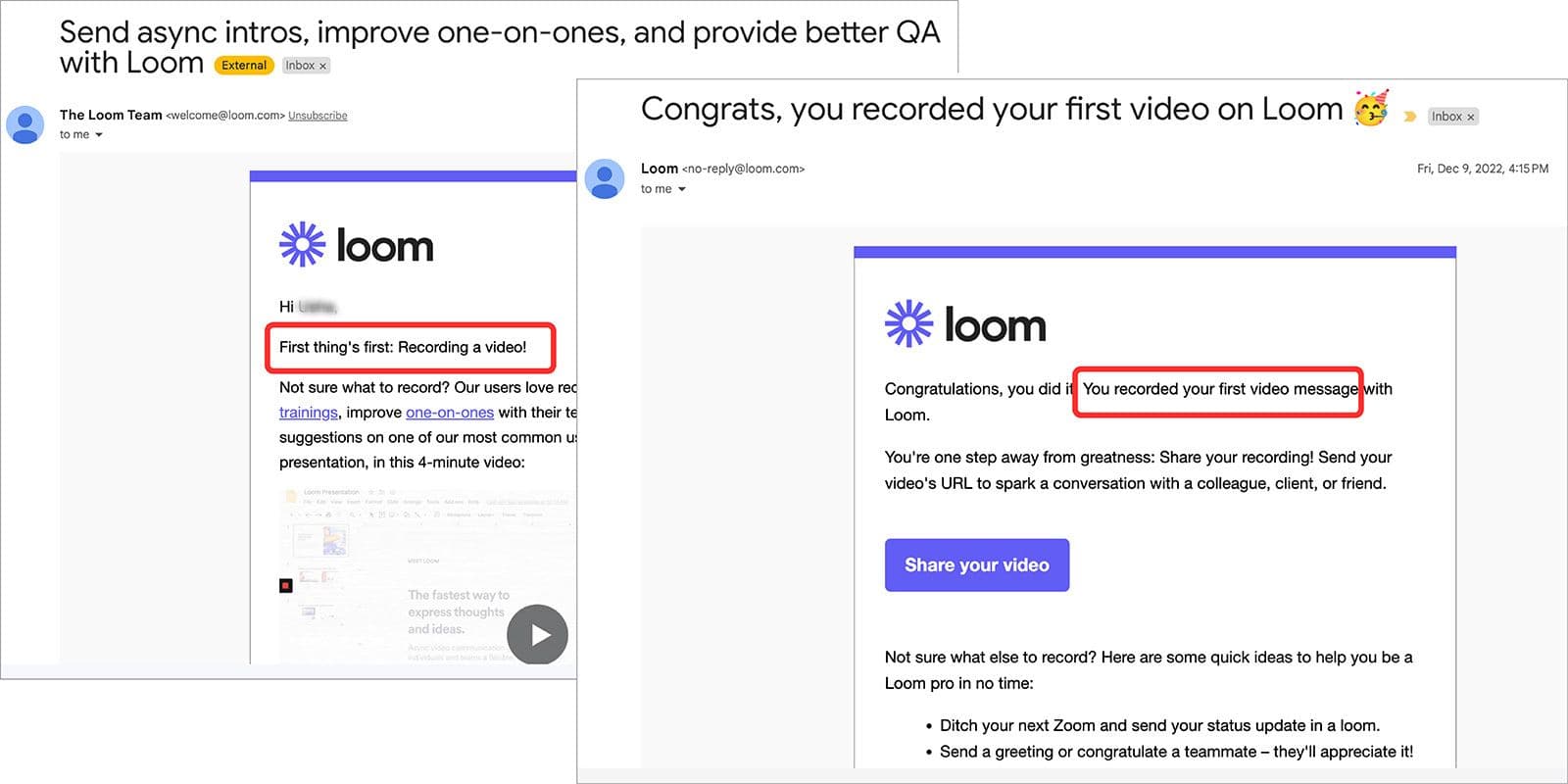
Loom also personalizes the subject line based on what the user signed up for.

As the users get close to the trial end date, Loom sends timely reminders with an easy link to add their payment details. From here, converted users are diverted to a different track.

Depending on where your users are in your onboarding process, the length of the trial period, and usage limitations in the freemium model, you can craft similar emails based on Amplitude data to complement and expedite the onboarding experience.
2. Milestone emails
Milestone emails are triggered when users cross or need a nudge to reach an important “aha” moment in product usage.
Some popular milestone emails are triggered upon completion of onboarding or customers’ wins. Some guide users toward their next milestone or as part of a gamified customer journey. These emails help reduce activity churn with timely intervention.
Canva’s milestone emails are a great example.
Canva uses badges to show its continued appreciation of users at each milestone.

The user gets bragging rights, and Canva gets its loyalty and word-of-mouth marketing. Win, win! They send these amazing badges in emails with a gentle push to take the next steps.
The goal here is to create sticky users and keep them on the path to conversion with a lot of cheering. Gamifying the customer journey to encourage more product usage is clearly working for the incredibly successful Canva. The company also nudges users to take the next step using the product.

3. Recap emails
Recap emails can be the ultimate tool for driving product engagement for a product-led growth (PLG) company. Reminding users of the value they are getting with the product is another opportunity to improve retention and reduce churn.
The popularity of recap emails is reflected in all those Spotify Wrapped-inspired efforts. Which is a great idea in theory. But to cut through hundreds of such emails, you need to deliver value that appeals to your users and personalization is the way to nail it.
Personalize the insights, announcements, and round-ups based on the user’s activity in the product and their role. For example, sending the same insights to an individual contributor using your product for a personal project and an admin user who primarily coordinates cross-functional work between two teams is not impactful for one or both types of users.
Here’s an example. Stack Moxie uses Inflection.io to deliver to their users an automated QBR email featuring success metrics based on a combination of the users’ product activity and CRM data.
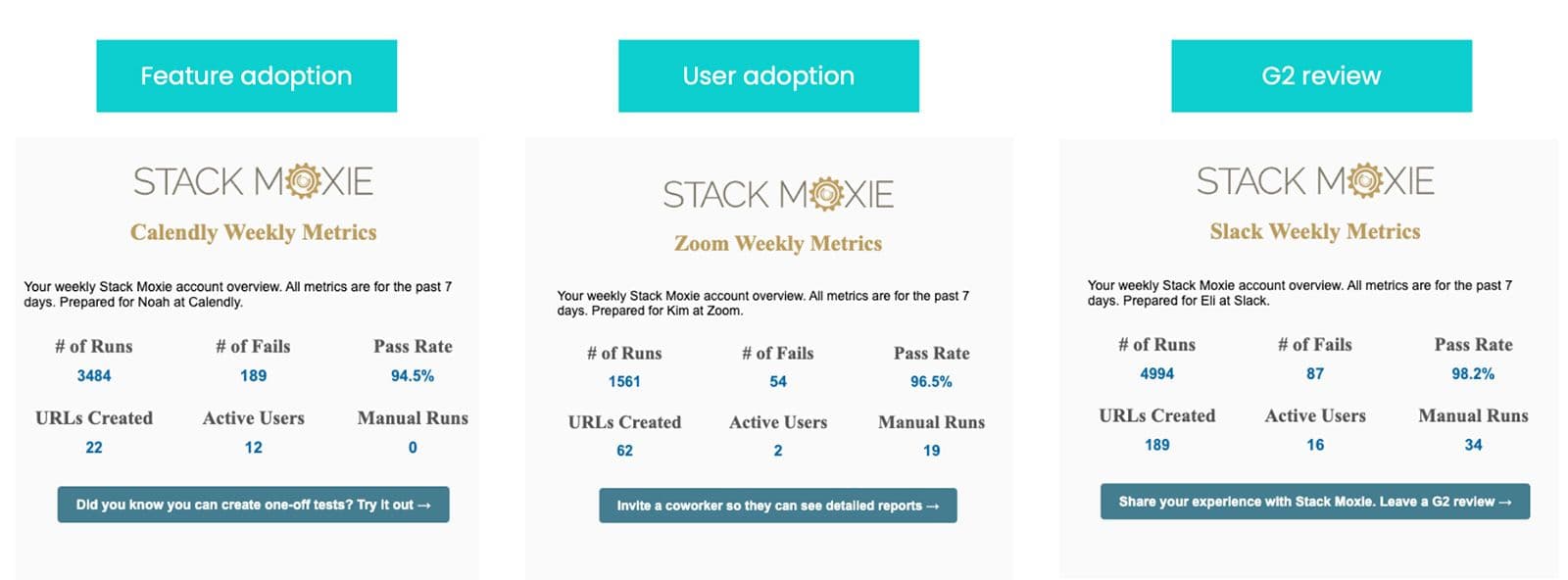
When done right, these emails can create sticky users, re-engage inactive users, and support the Sales and Success teams to secure more conversions and account expansions.
4. Reactivation emails
A reactivation strategy should be part of every PLG company’s growth strategy to ensure that churn is not permanent. And product-led reactivation campaigns are worth the investment.
Reactivating a lost customer is definitely harder than converting a trial user. Because, they already checked out the product and were unimpressed with the experience or worse, frustrated. Convincing such customers to take a second chance requires the right strategy and incentive.
The key lies in personalizing the reactivation campaign for the PLG customer.
Gathering intel from an off-boarding survey can definitely help in segmenting lost customers by their reason for churn. But not all customers take an exit survey. If you don’t have the exact reason for churn, look into the former customer’s product activity for clues. Traceback steps and figure out the friction points along their product journey that led them to leave.
Once you identify the reason/s for churn, you can add many dimensions to your automated product-led reactivation campaigns to make them truly personalized for every lost customer.
Use a combination of the off-boarding survey response, the former users’ product behavior, and firmographic factors like org size to orchestrate the right PLG reactivation email campaign.
Here are a couple of examples. Avocode and Asana clearly state what improved in their products. Avocado goes a bit further to persuade users with a discount.
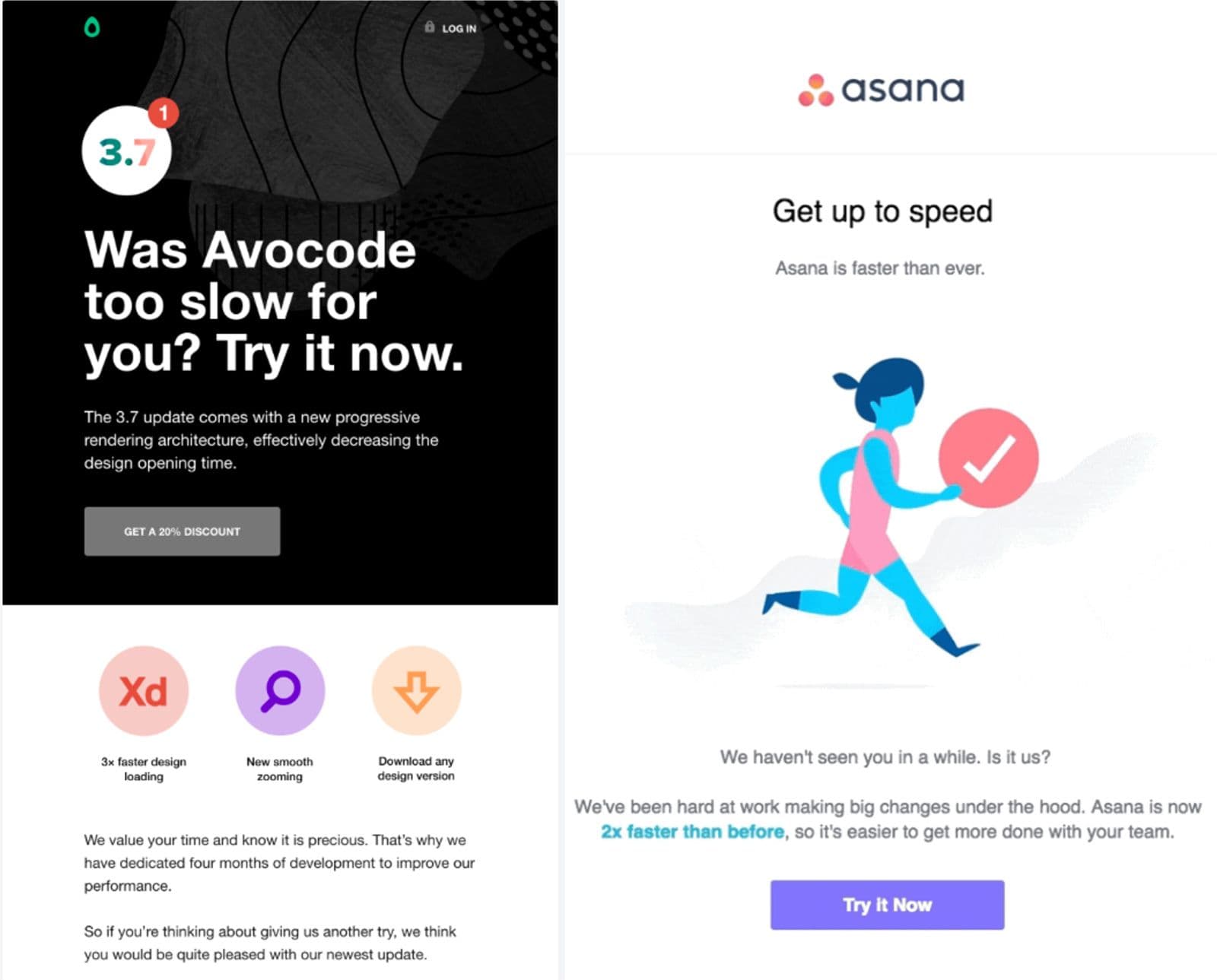
You can send similar targeted emails with product experience improvements to the list of lost customers who gave feedback about friction in the product or user experience. Show them proof of improvement and win back their trust.
You can also offer a limited-time trial to reactivate their account and encourage trying out the new and improved features. For example, a user churned during the onboarding process can be offered an extended trial pick up where they left off.
5. Share or invite emails
A user’s positive product experience and a personal recommendation to their team or friends can set off a self-sustaining and perpetual PLG growth loop for your business. But waiting for organic word of mouth to catch on might keep you waiting for a while.
Share or invite emails are one of the most effective ways to encourage your happy customers to spread positive vibes about your product. Let’s see how.
Many B2B SaaS products are built to enable or ease collaboration at work. The value of such products increases as more users start using them, creating a network effect.
Product-led companies can build campaigns in varied contexts such as asking customers to invite their team to try a new limited access feature, a new product’s beta version, join the product’s user community, etc. Here are some examples from top PLG companies.
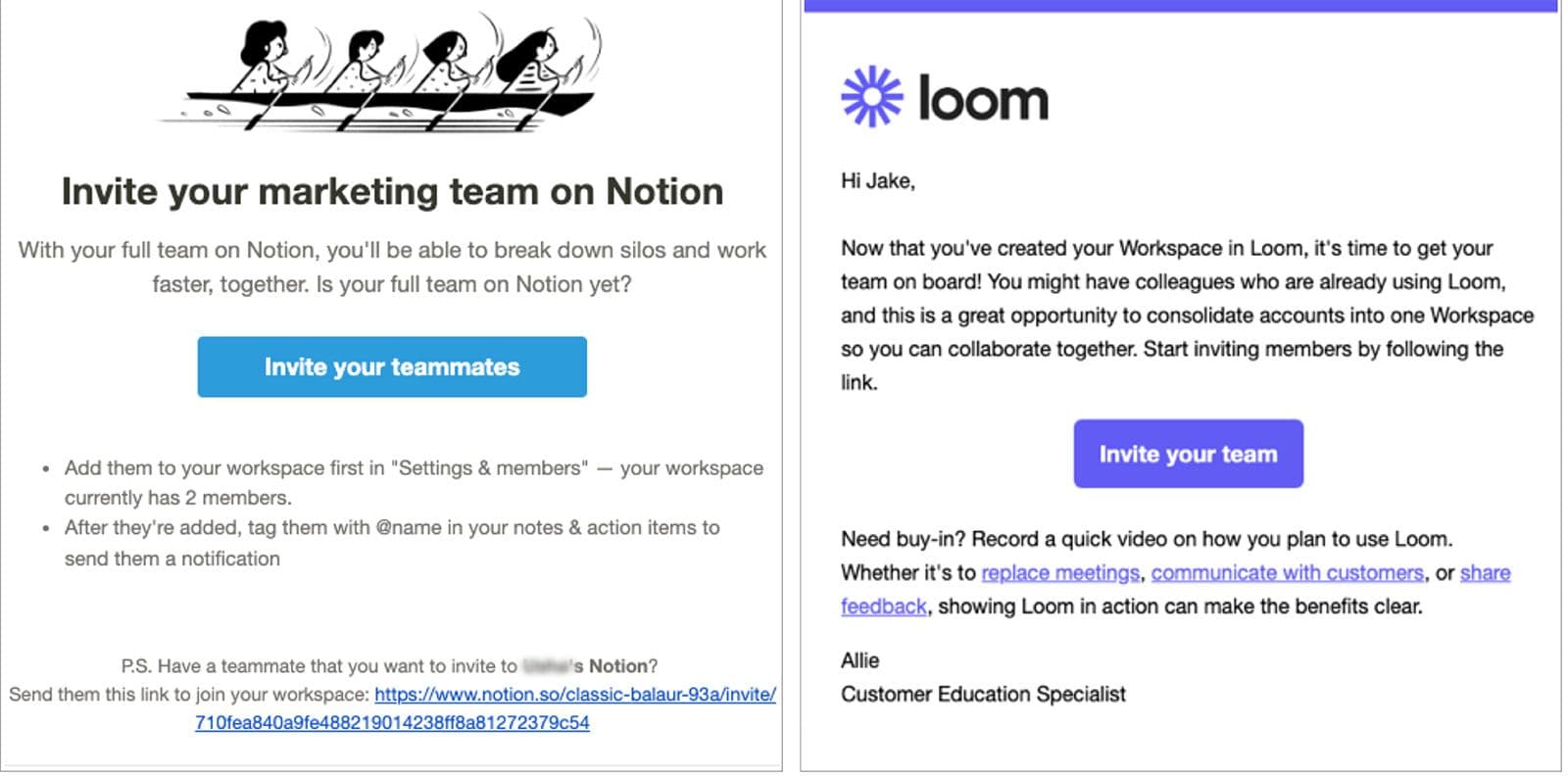
You can also leverage email to remind the sender if the invitation is not accepted yet. Asana drives it home with emails like this one.

You can also incentivize referrals for some extra motivation. In PLG, a referral need not offer a discount or gift coupon; it can also mean unlocking new product usage limits or premium features for the referrer and also for the referred. Here are some examples.

A personalized PLG share or invite email delivered with the right context and right incentives can help spark your customers’ interest to share their positive experiences.
6. Upsell and cross-sell emails
The common challenge for PLG companies in expanding accounts is that when it comes to upgrades, oftentimes your user is not the decision maker or buyer. And, the buyer need not be an active user. So, your PLG go-to-market team needs to employ a communication channel other than the product itself to pitch an upsell to the right audience.
Use product qualified leads (PQLs) as a reliable judge of user intent to buy. If you haven’t identified PQLs already, take a look at your Amplitude data to identify the product signals that lead to successful conversions.
If your target customer is not an individual user, but a team or enterprise account then you need a bit more to get the purchase intent right. Product Qualified Accounts (PQAs) are a combination of product signals and firmographic information such as team and company size, customer’s role in the org, etc. Identifying and optimizing PQAs is key for the expansion campaign to be more effective.
Let’s say you want to upsell the annual subscription target account of 50-100 team members on a monthly billing cycle when they are over 80% of the product usage quota with more than one week remaining. You can set up the PQA to trigger an internal alert to Sales when all the criteria are met. And at the same time, you can also automate emails like the one below.
And the email that goes to the buyer’s email can be from the CSM’s email address suggesting an upgrade to an annual plan with details of the benefits for the customer.
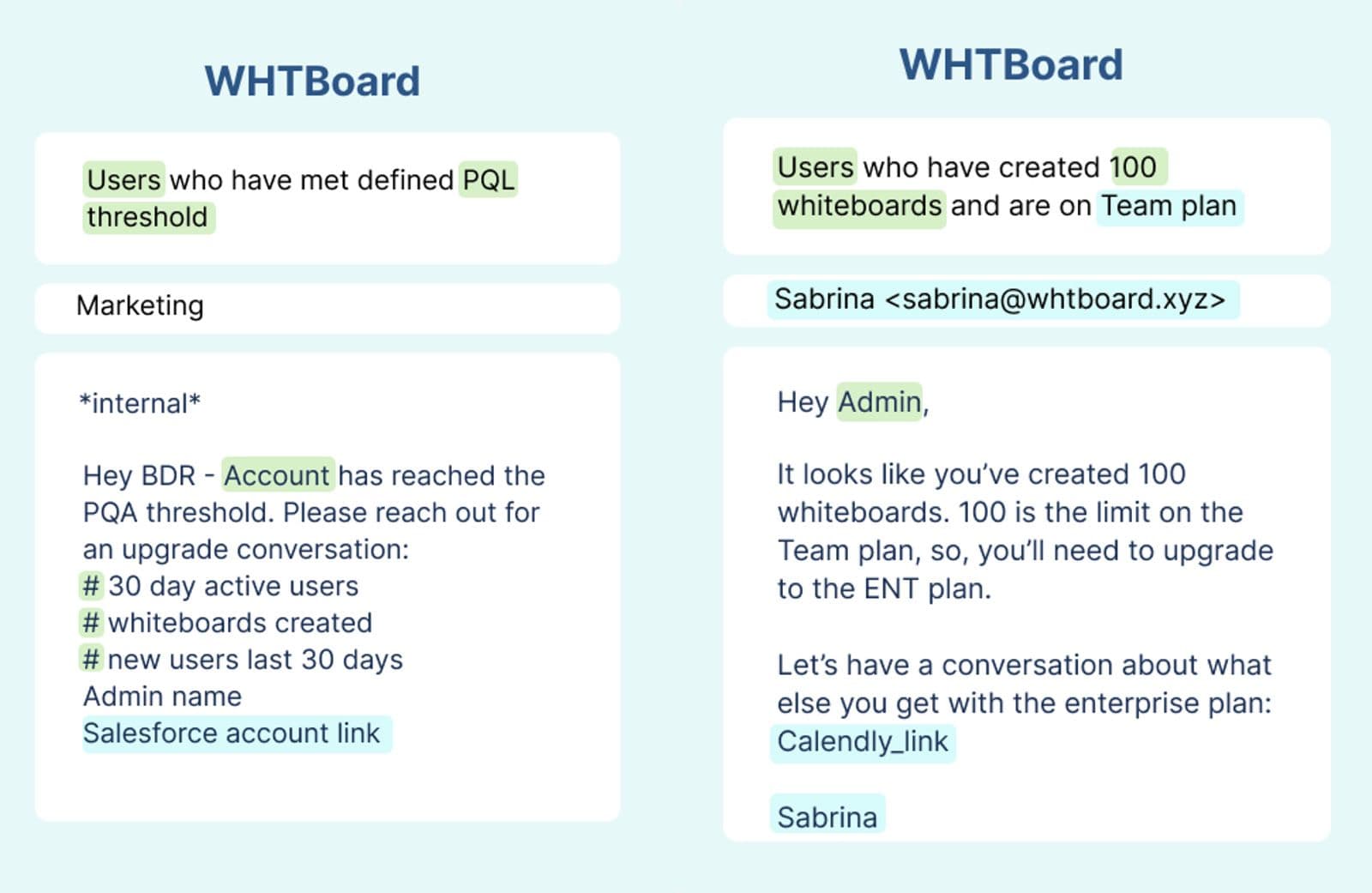
Roping in Sales or Success teams can help PLG companies to forge a better buying relationship with the target customer. Your emails can also encourage scheduling a call. When the team has all the relevant information on the customer’s product and CRM activity, the conversation becomes more authentic and easier.
Powering personalized PLG upsell and cross-sell emails with the right product activity and CRM data boosts campaign efficiency. Your upsell and cross-selling campaigns are automatically effective when they speak directly to the customers’ needs.
7. Abandoned cart emails
It is a common scenario in PLG businesses that the basic tiers of the product are purchased via a relatively simple online transaction similar to an e-commerce site. This similar shopping experience means a common menace in both business types: abandoned carts.
Users may not complete checkout due to many reasons like distractions, indecisiveness, or even technical issues. Abandoned cart emails can be just a simple reminder that a distracted user needs to get back to the billing page. Remind them where they left off and direct them to the billing page.
Sauce Labs sends their first reminder email on the same day their users visit the pricing page. The PLG abandoned cart email lists the value of their product as reasons to complete the purchase. They also show the starting price, a link to a detailed pricing page, and a big red button to complete the transaction. They send a reminder promptly two days after to follow up.

The campaign has been a huge success, generating hundreds of thousands in new ARR each year.
A great PLG cart abandonment email like the above example is personal and contextual. It is delivered at the right time to the PQLs and PQAs with the right information and motivation to complete the purchase.
In summary
Your product is the primary channel for growth but you should leverage emails to reach out to distracted and disengaged customers at scale. You might have noticed that personalization is a recurring theme in this post. That’s because it’s the backbone of a great product-led growth campaign.
The success of your PLG comms greatly depends on personalized communication at scale. And tailoring customer experience with the right message at the right time is how you can build a sustainable product-led business.
Check out our contributions in Amplitude’s latest Product-Led Growth Guide Volume 1: What Is PLG?

Dave Rigotti
Co-founder, Inflection.io
Dave Rigotti is the co-founder and CEO of Inflection.io. Founded by ex-Marketo executives, Inflection is the first B2B marketing and customer communication automation platform built for product-led companies. Our vision is to make it easier for PLG businesses to guide users to quicker onboarding, better adoption, and get more revenue and pipeline. Dave held marketing leadership roles at Adobe, Marketo, and Bizible. Dave is passionate about everything PLG, marketing, and BBQ.
More from Dave





